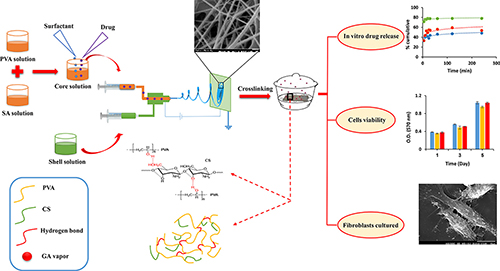Copyright © 2022 Foshan MBRT Nanofiberlabs Technology Co., Ltd All rights reserved.Site Map
The skin prevents infection and contamination entering the body, and wound dressings are one of the most serious tools in wound healing. In the present work, the biocompatibility and swelling tendency of nanofibers increased by adding alginates to a polymer solution is investigated. Glutaraldehyde was used in different methods to strengthen nanofibers, and it was found that a better cross-link was made from the combination of glutaraldehyde with the polymer solution before electrospinning. As the use of drug accelerates the healing process, dexpanthenol was added to the polymeric composition of polyvinyl alcohol (PVA) and sodium alginate (SA) using a blending method. The resulting composition was then used as the core of the nanofibers, and drug release was controlled by different shells. The results showed that the presence of chitosan 1% (w/v) in the shell side of nanofibers helped better control the drug release. Also, the drug release from dexpanthenol-loaded wound dressing followed the Fickian diffusion mechanism with the Korsmeyer-Peppas model. MTT analysis and cell culture indicated that dexpanthenol-loaded PVA/SA/Triton-Chitosan nanofibers not only were nontoxic to the fibroblast cells but also appropriately affected the cellular attachment and morphology. It was revealed that PVA/SA/Triton-Chitosan nanofibers could be used for tissue engineering applications.

Published:2021
Journal:Journal of Drug Delivery Science and Technology
Impact Factor:2.771
Paper link:https://www.sciencedirect.com/science/article/abs/pii/S177322471931617X